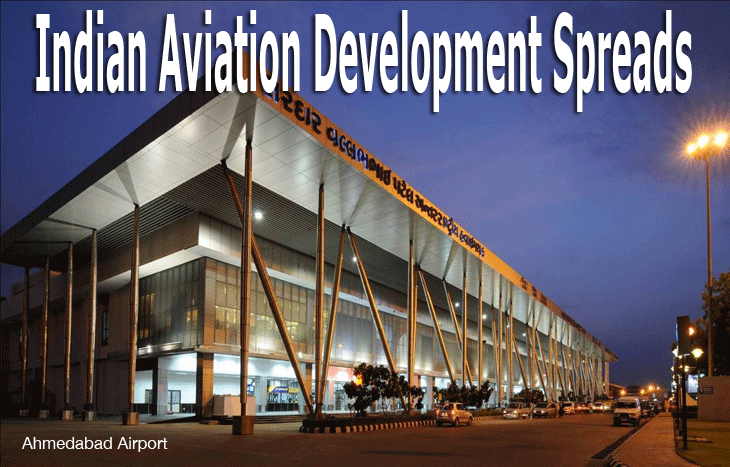
The financial condition of India’s
carriers has not deterred stakeholders from continuing—or
even initiating—infrastructure projects that will help
the aviation sector flourish.
This time around, little India
is waking up to the immense potential of air cargo.
No longer limited to the metro
cities, states in the west of India, like Gujarat and Maharashtra
and even Madhya Pradesh in central India, are chalking out elaborate
plans.
The Gujarat government, for example,
has revamped its aviation department. At the launch of the Gujarat
civil aviation policy in June 2010, the government note pointed
out that, “air cargo movement has grown by nearly 19 percent
as compared to 10 percent and 9 percent of growth in shipping
and railways. In the context of Gujarat, one of the most industrialized
states in India, the government wishes to encourage private
players to utilize the air-cargo route and include suitable
provisions for making a world class cargo hub in Gujarat.”
According to that policy, the
federal government tasked the newly-created Gujarat State Aviation
Infrastructure Company Limited (GUJSAIL) for the development
of aviation and related infrastructure in the state. Hence,
the recent invitation for proposals from entrepreneurs to start
cargo and passenger services within the state.
One of the most industrialized
states of the country, Gujarat has one of the fastest growing
economies in India. According to a report that appeared in The
Economist in July last year, the state’s infrastructure
could be compared with that of Guangdong in China. The state
not only has a better road network but also does not interfere
with entrepreneurial corporations. This has led experts to comment
that the state’s keenness to develop its aviation business
augured well.
 Consider
the facts: Gujarat accounts for 16 percent of India’s
industrial output and 22 percent of its exports. While 11 airstrips
across the state have been identified, the government has clearly
specified the kind of aircraft that would be needed. According
to Vipul Mitra, (left) who heads the state’s tourism and
aviation departments, the federal government was working on
a strategy to ensure long term sustainability of aviation services. Consider
the facts: Gujarat accounts for 16 percent of India’s
industrial output and 22 percent of its exports. While 11 airstrips
across the state have been identified, the government has clearly
specified the kind of aircraft that would be needed. According
to Vipul Mitra, (left) who heads the state’s tourism and
aviation departments, the federal government was working on
a strategy to ensure long term sustainability of aviation services.
Even as moves to start aviation
services take place, plans that were drawn up to establish an
air cargo hub for perishable goods at the Sardar Vallabhbhai
Patel International Airport at Ahmedabad are fructifying.
The airport’s cargo potential
is healthy. Ahmedabad airport handles only two percent of the
cargo from India. Of this, 44 percent is domestic cargo and
56 percent is international cargo.
Piloted by the Gujarat Agro Industries,
another federal government enterprise, the cargo hub is expected
to cater to the huge quantities of pharma products, vegetables,
fruits, and flowers that the state of Gujarat exports. While
the airport is within easy reach of Middle Eastern countries,
it will cater to the diaspora from Gujarat spread out all over
the world. To begin with, the cargo hub will be able to take
away a sizeable share of exports that are now being sent through
Mumbai airport. In fact, around 40 percent of the vegetables
sent out through Mumbai are from Gujarat. With the lack of space
at Mumbai and the traffic gridlock around the airport that is
an almost daily occurrence, perishables often cannot make it
to their destinations.
The Ahmedabad cargo complex—delayed
for around two years because of land issues—is all set
to start operations. With its three temperature-controlled cold
storages (zero, minus zero and plus 10 degree) and X-ray machines,
the cargo complex is, perhaps, one of the most modern in the
country. Incidentally, Emirates picks up around 170 tonnes of
cargo a week from Ahmedabad airport meant for the Middle East,
U.S., and Europe and in November, another Middle Eastern airline—Etihad
Airways—will start operations to Ahmedabad.
Meanwhile, barely 200 km from
Mumbai, cargo operations have recently started at Ojhar airport
in Nashik. The airport is owned by HAL (Hindustan Aeronautics
Limited, a government unit manufacturing aircraft for the Indian
Air Force—the Nashik division builds the Sukhoi planes
under license from its Russian makers) with private entrepreneur
Clarion Solutions managing the cargo complex. Perhaps what is
most special about the airport is that it can handle planes
like the AN-124s. The cargo complex comprises two warehouses,
an integrated packing center for perishables, cold storage,
screening, unitizing, ground handling services for airlines,
CCTV surveillance, bar-coding, labeling, and customs.
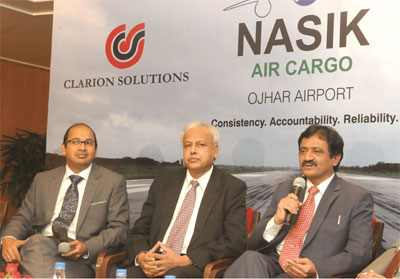
Announcing the start of cargo operations from Nasik's
Ojhar airport: (L-R) Ganesh Krishnan, CEO, Clarion Solutions
(Clarion is a subsidiary of Transworld Group, a leading coastal
shipping operator in the country); V. Ramnarayan, Vice-Chairman,
Transworld Group of Companies; and P. V. Deshmukh, MD, Hindustan
Aeronautics.
While this airport expects to
take away at least 25 percent of the cargo handled by Mumbai
airport every month, it will also cater to perishables including
pharma products, automobile parts, and engineering products.
Dubai-based Rus Aviation has been operating a flight a week
to the Ojhar air cargo hub. The carrier could increase the frequency
to three flights a week if customer response is good.
Tirthankar Ghosh
|






 Consider
the facts: Gujarat accounts for 16 percent of India’s
industrial output and 22 percent of its exports. While 11 airstrips
across the state have been identified, the government has clearly
specified the kind of aircraft that would be needed. According
to Vipul Mitra, (left) who heads the state’s tourism and
aviation departments, the federal government was working on
a strategy to ensure long term sustainability of aviation services.
Consider
the facts: Gujarat accounts for 16 percent of India’s
industrial output and 22 percent of its exports. While 11 airstrips
across the state have been identified, the government has clearly
specified the kind of aircraft that would be needed. According
to Vipul Mitra, (left) who heads the state’s tourism and
aviation departments, the federal government was working on
a strategy to ensure long term sustainability of aviation services.
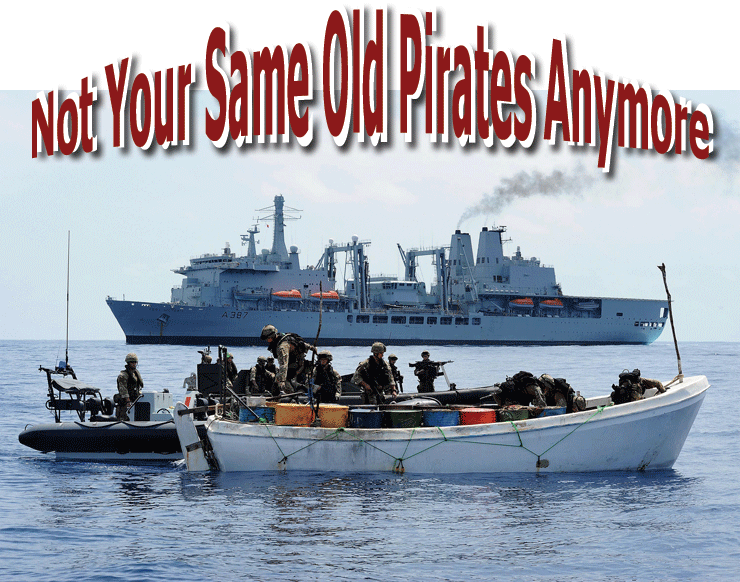
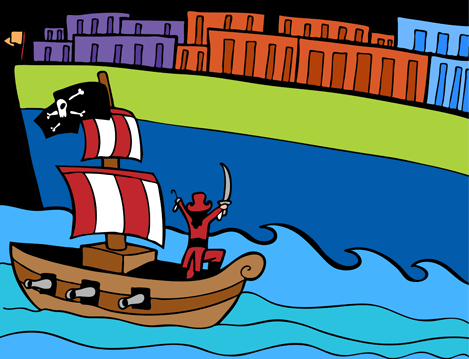 Pirates
of The Caribbean, Long John Silver, Peter Pan, and Erroll Flynn
movies dating back to the early 1930s have popularized the image
of pirates as fun and light-hearted characters.
Pirates
of The Caribbean, Long John Silver, Peter Pan, and Erroll Flynn
movies dating back to the early 1930s have popularized the image
of pirates as fun and light-hearted characters.
 Just
in time for summer comes a picture of Marek Kasiak, LOT Polish
Cargo Director, North America, in Warsaw a couple Christmas’
ago, reminding all of us that, like it or not, the days are
getting shorter and the Polish are getting a LOT bigger.
Just
in time for summer comes a picture of Marek Kasiak, LOT Polish
Cargo Director, North America, in Warsaw a couple Christmas’
ago, reminding all of us that, like it or not, the days are
getting shorter and the Polish are getting a LOT bigger.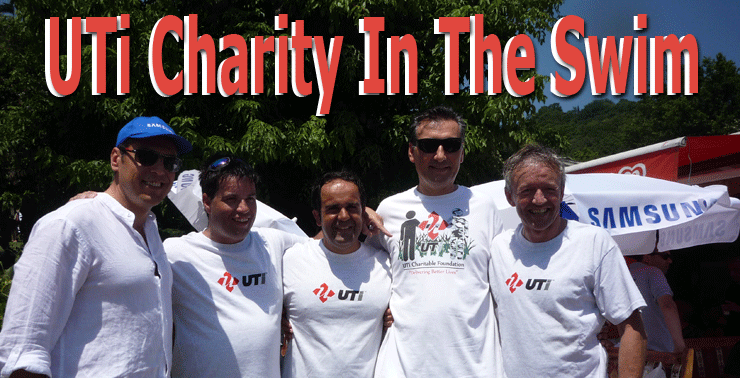 Getting
on swimmingly, UTi’s “Core Four” & supporter
(L toR) Irfan Erdim, Seth Walker, Tuna Gursoy, Abdullah Yesil,
and Hugo Duchemin.
Getting
on swimmingly, UTi’s “Core Four” & supporter
(L toR) Irfan Erdim, Seth Walker, Tuna Gursoy, Abdullah Yesil,
and Hugo Duchemin.

